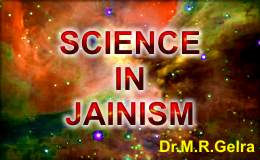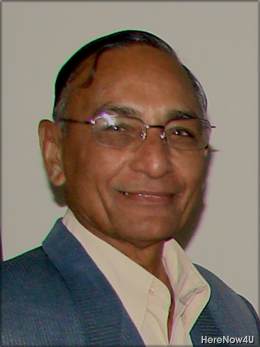
According to the Jains, the massless pudgala moves with tremendous velocity without gaining any mass. The parmanu can move from one end of the universe to the other in a unit fraction of time. It means that the Jain concept regarding the velocity of pudgala parmanu is much greater than the velocity of light. Recently an Indian scientist Prof. Sudersen has discussed about the particle, which moves with the velocity greater than the velocity of light. It is against the Einstein equation. The difficulty with the modern scientist is that they have categorized the material particles on the basis of proper mass and velocity whereas Jainology discusses massless fine pudgala on the basis of oily and dry tactility. It is interesting to quote the heading, which has appeared in press 'What's faster than the speed of light! Light. The details are as follows:
Scientists have apparently broken the universe's speed limit. For generations, physicists believed there is nothing faster than light moving through a vacuum - a speed of 300,000 Km per second.
But in an experiment in Princeton, New Jersey, physicists sent a pulse of laser light through cesium vapour so quickly that it left the chamber before it had even finished entering.
The pulse travelled 310 times the distance it would have covered if the chamber had contained a vacuum.
Researchers say it is the most convincing demonstration yet that the speed of light - supposedly an ironclad rule of nature - can be pushed beyond known boundaries, at least under laboratory circumstances.
This effect cannot be used to send information back in time," said Mr. Wang Lijun, a researcher with the private NEC Institute.
However, our experiment does show that the generally-held conception that 'nothing can travel faster than the speed of light' is wrong.
The results of the work by Mr. Wang, Mr. Alexander Kuzmich and Mr. Arthur Dogariu were published in the journal, Nature.
The achievement has no practical application right now, but such experiments have generated much excitement in the international community of theoretical and optical physicists.
Said Mr. Raymond Chiao, a physicist at the University of California in Berkeley who was not involved in the work: "This is a break-through in the sense that people have thought that was impossible."
Massless pudgalas, which are useful for living beings, include the waves of swasoswas vargana (breathing), bhasha vargana (speech) mano vargana (mind) and karmic matter attached to the soul. Vargana means the waves and its vibrations with a particular wavelength. The instrumental science is trying to exercise control over these varganas, but it is extremely difficult.
Massless pudgala is densely packed in the entire space.
The relationship of space and matter was not well understood in the field of science until the idea of energy fully developed. Nobel Laureate Erwin Schrödinger in the article 'What is matter' mentioned that the gravitational forces, scattered and diffracted light, are reaching the far end of the universe from the remote starts situated at the distant places. No space is left vacant. Jainology adds to it by accepting that the particles finer than photons exist, which are massless and may move with a greater velocity than the velocity of light. They are fully packed in the entire space but do not obstruct the movement of other pudgalas.
If we trace the history and development of the theory of Atom, in the field of physical sciences, we find that the beginning of twentieth century, was tremendously significant because of the discovery of electron, proton and later on of neutron. Scientists were very much hopeful that they were very near to, a knowledge of the ultimate building blocks of nature. But the continuing researches during the middle of 20th century, could discover a number of other fundamental particles.. It hampered the advancement of science in the field of particle physics. Scientists came to know that the nature is not so simple.
However, in the sixties of 20th century experiments were conducted in which protons were collided with other protons or electrons at high speeds, which indicated that they are in fact made up of smaller particles. These experiments showed that there are only three fundamental families of matter known as Electron family, Muon family and Tau family whose particles are named as 'up' Quark, the 'down' quark and the electron. It is believed that these quark particles originated right from the period of big bang of the universe and are fundamental particles. The particle physicists established that the universe around us consists of six fundamental 'Flavours; i.e. up, down, strange, charmed, bottom and top. These recent experiments carried out at CERN and SLAC on quarks have thrown light on the behaviour of the particles carrying forces, which are massless.
Stephen Hawking in his book 'A brief history of the time' has described four categories of the forces carrying particles. They are gravitational force, electromagnetic force, weak nuclear force and strong nuclear force. Except the weak nuclear force, rests of the three forces carry the particles of graviton, photon and gluon respectively. These particles do not obey the exclusion principle i.e. there is no limit to the number that can be exchanged and so they can give rise to a strong force.
The force carrying particles exchanged between matter particles are said to be virtual particles, because unlike 'real' particles, a particle detector cannot directly detect them. Even then they exist, because they do have a measurable effect: they give rise to forces between matter particles. These particles also exist in some circumstances as real particles, when they can be directly detected. These particles appear in the form of waves such as waves of light or gravitational waves. The behaviour of gluon particle is very unique and appears sometimes as metaphysical. However, experiments suggest that gluon, a massless particle must have been present right from the time of formation of quarks after big bang.
The outcome of these scientific studies is likely to lead us a long way in understanding the behaviour of Karmic particles which are massless and which control the actions of the soul i.e. self. It is evident from the above discussion that Jain philosophy's contribution in the field of material science is quite unique.
 Dr. Mahavir Raj Gelra
Dr. Mahavir Raj Gelra

